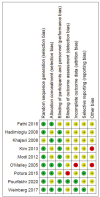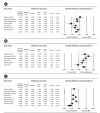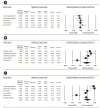Comparison of normal saline solution with low-chloride solutions in renal transplants: a meta-analysis
- PMID: 34233443
- PMCID: PMC8476298
- DOI: 10.23876/j.krcp.21.027
Comparison of normal saline solution with low-chloride solutions in renal transplants: a meta-analysis
Abstract
Background: Normal saline solution (NSS) has been the fluid of choice for renal transplant patients, but it can lead to hyperchloremic acidosis and hyperkalemia. This study was performed to compare the safety profile of low-chloride solutions with that of NSS in renal transplant patients.
Methods: We conducted a systemic review search on PubMed, Embase, and the Central Cochrane Registry. Randomized clinical trials (RCTs) and matched cohort studies involving NSS as the control arm and low-chloride solutions as an intervention arm were chosen. The standardized mean difference for continuous variables, the odds ratio (OR) for discrete variables, and a 95% confidence interval (CI) for effect sizes were used. A p-value of <0.05 was considered statistically significant. Analysis was performed using a random-effects model irrespective of heterogeneity, which was evaluated using I2 statistics.
Results: Nine RCTs and one cohort study with a total of 726 patients were included. After transplantation, serum potassium was significantly lower in the low-chloride group (standardized mean difference compared to NSS group, -0.38 mEq/L; 95% CI, -0.66 to -0.11; p = 0.007). Similarly, postoperative chloride was lower in the low-chloride group (-2.41 mEq/L [-3.34 to -1.48], p < 0.001). No statistically significance was observed in delayed graft function (OR, 0.98 [0.56-1.69], p = 0.93), day 3 creatinine (-0.14 mg/dL [-0.46 to 0.18], p = 0.38), or day 7 urine output (-0.08 L [-0.29 to 0.12], p = 0.43).
Conclusion: Use of NSS during renal transplant leads to increased incidence of hyperchloremic acidosis with subsequent hyperkalemia, but clinical significance in the form of delayed graft function or postoperative creatinine remains comparable to that of low-chloride solutions.
Keywords: Delayed graft function; Dialysis solutions; Kidney transplantation; Ringer’s lactate; Saline solution; Sodium bicarbonate.
Conflict of interest statement
All authors have no conflicts of interest to declare.
Figures






Similar articles
-
Balanced Crystalloids Versus Normal Saline in Kidney Transplant Patients: An Updated Systematic Review, Meta-analysis, and Trial Sequential Analysis.Anesth Analg. 2024 Jul 1;139(1):58-67. doi: 10.1213/ANE.0000000000006932. Epub 2024 Apr 5. Anesth Analg. 2024. PMID: 38578867
-
Normal Saline Versus Balanced Crystalloids in Renal Transplant Surgery: A Double-Blind Randomized Controlled Study.Cureus. 2021 Sep 24;13(9):e18247. doi: 10.7759/cureus.18247. eCollection 2021 Sep. Cureus. 2021. PMID: 34722040 Free PMC article.
-
A randomized, double-blind comparison of lactated Ringer's solution and 0.9% NaCl during renal transplantation.Anesth Analg. 2005 May;100(5):1518-1524. doi: 10.1213/01.ANE.0000150939.28904.81. Anesth Analg. 2005. PMID: 15845718 Clinical Trial.
-
Normal Saline Versus Low Chloride Solutions in Treatment of Diabetic Ketoacidosis: A Systematic Review of Clinical Trials.Cureus. 2022 Jan 17;14(1):e21324. doi: 10.7759/cureus.21324. eCollection 2022 Jan. Cureus. 2022. PMID: 35186583 Free PMC article. Review.
-
Half Saline-Bicarbonate Solution as Intraoperative Fluid Replacement Therapy Leads to Less Acidosis and Better Early Renal Function During Deceased-Donor Transplant.Exp Clin Transplant. 2020 Feb;18(1):34-38. doi: 10.6002/ect.2018.0328. Epub 2019 Apr 17. Exp Clin Transplant. 2020. PMID: 30995895 Clinical Trial.
Cited by
-
Perioperative balanced crystalloids versus normal saline during kidney transplantation: a systematic review and meta-analysis of randomized controlled trials.Int Urol Nephrol. 2024 Jul;56(7):2195-2213. doi: 10.1007/s11255-023-03936-z. Epub 2024 Feb 13. Int Urol Nephrol. 2024. PMID: 38349600
-
European Society of Intensive Care Medicine clinical practice guideline on fluid therapy in adult critically ill patients. Part 1: the choice of resuscitation fluids.Intensive Care Med. 2024 Jun;50(6):813-831. doi: 10.1007/s00134-024-07369-9. Epub 2024 May 21. Intensive Care Med. 2024. PMID: 38771364
-
Pyruvate as a Potential Beneficial Anion in Resuscitation Fluids.Front Med (Lausanne). 2022 Jul 12;9:905978. doi: 10.3389/fmed.2022.905978. eCollection 2022. Front Med (Lausanne). 2022. PMID: 35991638 Free PMC article.
-
In Vivo Effects of Balanced Crystalloid or Gelatine Infusions on Functional Parameters of Coagulation and Fibrinolysis: A Prospective Randomized Crossover Study.J Pers Med. 2022 May 31;12(6):909. doi: 10.3390/jpm12060909. J Pers Med. 2022. PMID: 35743694 Free PMC article.
-
Association between normal saline infusion volume in the emergency department and acute kidney injury in heat stroke patients: a multicenter retrospective study.Ren Fail. 2024 Dec;46(1):2294151. doi: 10.1080/0886022X.2023.2294151. Epub 2024 Jan 4. Ren Fail. 2024. PMID: 38178374 Free PMC article.
References
-
- O’Malley CM, Frumento RJ, Hardy MA, et al. A randomized, double-blind comparison of lactated Ringer’s solution and 0.9% NaCl during renal transplantation. Anesth Analg. 2005;100:1518–1524. - PubMed
-
- Belani KG, Palahniuk RJ. Kidney transplantation. Int Anesthesiol Clin. 1991;29:17–39. - PubMed
-
- Murphy BA. Anesthesiologist’s manual of surgical procedures, 3rd ed. Anesth Analg. 2004;99:314.
-
- Wilkes NJ, Woolf R, Mutch M, et al. The effects of balanced versus saline-based hetastarch and crystalloid solutions on acid-base and electrolyte status and gastric mucosal perfusion in elderly surgical patients. Anesth Analg. 2001;93:811–816. - PubMed
LinkOut - more resources
Full Text Sources

